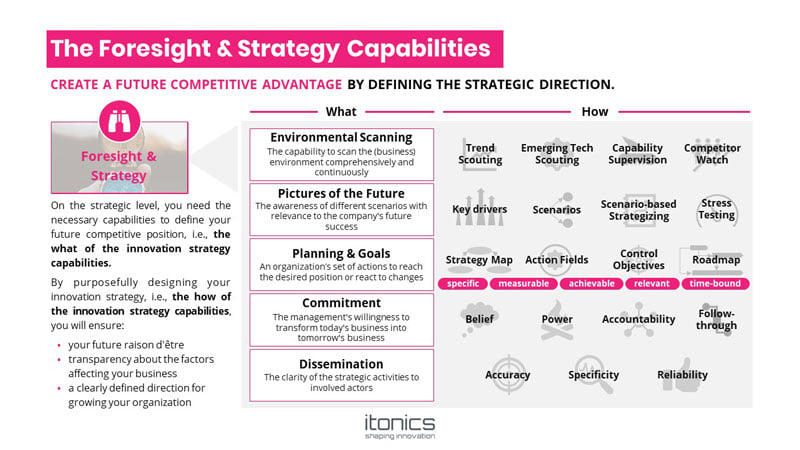Recent global events have set in motion a ripple effect of change. However, the truth is that there have been other events or developments that have triggered significant shifts before 2020, and there will be other agents of change well after 2021.
To navigate ongoing global and local changes, we need to be prepared for uncertain futures. Foresight is a powerful tool that organizations can utilize to anticipate and lay the necessary groundwork for different probable futures.
What is foresight and strategy?
Foresight is an umbrella term that refers to a structured and systematic way of identifying possible futures to be able to prepare accordingly. Several tools and methodologies are available to help guide Foresight efforts. Following successful completion of the Foresight stage, organizations can align their strategy to answer future opportunities and challenges.
The future holds both growth potential and obstacles. Foresight activities enable organizations to position themselves to adapt to this future. But identifying opportunities and challenges alone will not guarantee growth. These activities need to be coupled with action, which requires plotting roadmaps and assessing the best avenues for growth. Strategic action needs to be developed as a result of an in-depth understanding of plausible futures. Strategic Foresight actions are likewise strengthened when this understanding is filtered through a process of envisioning the performance of organizational capabilities and operations in the imagined futures.
The systematic collecting, interpreting, and prioritizing activities that make up the Foresight stage in end2end innovation yields the most value when it is participatory and aligns all stakeholders and employees to Strategic Foresight commitments.
Why is it important for end2end innovation?
To innovate requires imaginativeness, resourcefulness, and competencies. Knowing what to imagine, which resources to invest in, and which areas of the organization to capacitate can be a daunting undertaking. Systematic Foresight and Strategy support this process by involving diverse input and multi-touch navigation. Successful innovation is a non-linear journey that can be systemized to create clear pathways for implementing market-fit ideas.
Foresight and Strategy initiates informed and intelligent decision-making and roadmapping. This stage also requires participation and collaboration, which creates the foundations for committed action during later stages. Using Foresight activities to understand emerging transitions, innovation leaders can distinguish areas of opportunity and help steer their organizations towards greater competitive advantage.
As part of the Strategic Foresight stage, environmental scanning provides an opportunity to look beyond the most immediate and obvious changes in an organization’s future. Disruptive innovation calls for organizations to pay attention to shifts on the fringes and to interpret and translate such shifts. Too often, business leaders only look within the boundaries of their own industry, which provides a limited view on global transitions. Using several Foresight KPIs counters this tendency and compels innovators to take a 360-degree view.
Strategic Foresight competencies act as dynamic organizational capabilities that contribute to positive adaptability. When teams can imagine futures beyond present realities, they can maintain competitiveness by enhancing existing assets or creating new assets. While the future is an extension of the present—with familiar drivers and needs—it is at the same time wholly unknown and requires agility. Strategic Foresight activities can both ground future decision-making as well as catapult creative solutions-orientated ideation.

The ITONICS Control Objectives for Innovation Management (COFIM) provides clear guidance on managing innovation across strategic and operative objectives, with key performance indicators to support effective and controlled innovation.
Who can make use of foresight and strategy?
Leaders, decision-makers, and teams in all fields that manage and help navigate uncertainties and initiate suitable responses engage in Strategic Foresight. This capability helps organizations consider the future as both something to be prepared for, and as uncertainty that can be shaped to some degree. Foresight and Strategy activities help organizations and individuals move from reactive to proactive approaches, and these dynamic capabilities continuously drive growth.
Continuous Foresight and Strategy practices also help cultivate organizational and leadership capabilities to switch mental models rapidly, should the situation require. Feedback loops assist teams to be constantly participatory and aware of developing changes. To manage uncertainty and initiate appropriate rapid responses, decision-makers must effectively identify how to configure and reconfigure resources that match the environment.
![]() Foresight includes environmental scanning, which scans the environment for signals of shifts in societal, technological, environmental, economic, and political landscapes.
Foresight includes environmental scanning, which scans the environment for signals of shifts in societal, technological, environmental, economic, and political landscapes.
![]() Understanding the driving forces of these shifts assists in clustering together short, medium, and long-term opportunities and challenges.
Understanding the driving forces of these shifts assists in clustering together short, medium, and long-term opportunities and challenges.
![]() Develop descriptions of the evolutionary and transitory states, taking into account the drivers and implications.
Develop descriptions of the evolutionary and transitory states, taking into account the drivers and implications.
![]() Envision plausible futures and identify what success would look like in those futures.
Envision plausible futures and identify what success would look like in those futures.
![]() Create a strategy that reflects organizational alignment, capacity building, and transformational factors.
Create a strategy that reflects organizational alignment, capacity building, and transformational factors.
How a Hydraulics, Structural Mechanics Corporation Simplified its Foresight and Strategy Process
Our biggest challenge was the connection and knowledge sharing between our employees and the establishment of a more integrated process. KBS reacted accordingly by breaking down traditional organizational structures, partnering with the solution provider ITONICS.
Head of Idea Management, KSB
The Challenge
Founded in Frankenthal, Germany, in 1871, KSB has a presence on all continents with its own sales and marketing organizations, manufacturing facilities, and service operations, employing more than 15,000 people. As an industry leader in the supply of pumps, valves, and related systems, KSB needed to ensure a sustainable competitive edge in an increasingly digital landscape.
To remain competitive, the organization knew it must stay proactive and constantly make informed decisions based on broader landscapes. Emerging trends and rapid technological advances needed to inform strategy and mobilization mechanisms needed to be easily implemented and easy to use. Some outdated frameworks did not support end2end innovation goals, and new systems were required to address siloed ideation, the ability to assess global and local changes and impact and encourage participation across organizational divisions.
POTENTIAL PITFALLS
During Foresight and Strategy stages, some common pitfalls are:
- Reliance on single pieces of information to inform strategy
- Internal biases in decision-making
- Viewing Foresight and Strategy as a singular occurrence as opposed to a continuous activity
- Over-optimism in results expectations without strengthening the foundational capabilities for innovation
- Foresight needs dedicated roles and processes as well as cross-organizational input
To transition to more modern and digital idea management with the possibility to extend to innovation management and establish a transparent platform for creativity, communication, and potential for development. To increase the degree of openness (global and external) and navigation of content towards trends and technologies.
The Solution
To break down internal knowledge silos, KSB implemented a digital platform where more than 7,000 users could submit their ideas and participate in the innovation process. The digitization of the idea management process meant that employees could participate in dedicated areas depending on their roles and expertise within the organization.
Each idea was assigned to a specific idea category (e.g., work safety, resource efficiency, etc.), which was then evaluated by an appropriate expert who decided on the official acceptance of the submission. Submissions for improvement with a calculable benefit under € 1,500 become part of a lottery, whereas ideas with a benefit of more than € 1,500 undergo a special assessment and are awarded and integrated separately.
The platform has been expanded within KBS since 2019. This extension allows direct monitoring of competitors for assessing the company’s business model. All of the information can now be bundled into action fields (clusters) and then linked together to be analyzed in a temporal context. Ultimately the innovation board decides which cluster findings to transfer to bigger projects or directly implement in the organization. The defined innovation fields can also support further idea campaigns or subsequent innovation processes.
The Result
The digitization of idea management processes and the consequent expansion of the platform to include ‘Corporate Foresight’ and ‘Competitor Analysis’ yielded a digitally-enabled organizational cultural change towards an agile performance engine. KSB digitalized the entire manual process from idea submission to assessment to develop faster improvement processes. The processing time of an idea from submission to implementation continuously decreased by more than 60% (the reference year 2017).
Employees can comment, like, and discuss each other’s ideas—on the platform and offline—which makes knowledge sharing far more accessible across the organization.
Gamification and targeted incentivized campaigns increase the system’s attractiveness and user motivation. Ideas are processed with more openness, improving the quality and thematic diversity of all submitted ideas. The platform serves as a single point of truth that makes the process more efficient and valuable.
By incorporating the expertise of various departments, most topics are handled more dynamically in the Foresight process, reducing knowledge silos. It is easier to identify experts and the appropriate contact person in each specific field. Cross-departmental cooperation is encouraged while the synergy effects between the company suggestion system and corporate foresight become visible. It is more feasible to identify Strategic innovation fields for growth in potential attractive markets and use them to generate new ideas.
Read the full success story of KSB here!












